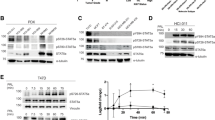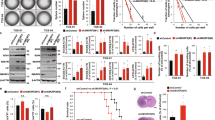Abstract
Somatostatin receptors (sst1–5) are present in different types of tumors, where they inhibit key cellular processes such as proliferation and invasion. Although ssts are densely expressed in breast cancer, especially sst2, their role and therapeutic potential remain uncertain. Recently, we identified a new truncated sst5 variant, sst5TMD4, which is related to the abnormal response of certain pituitary tumors to treatment with somatostatin analogs. Here, we investigated the possible role of sst5TMD4 in breast cancer. This study revealed that sst5TMD4 is absent in normal mammary gland, but is abundant in a subset of poorly differentiated human breast tumors, where its expression correlated to that of sst2. Moreover, in the MCF-7 breast cancer model cell, sst5TMD4 expression increased malignancy features such as invasion and proliferation abilities (both in cell cultures and nude mice). This was likely mediated by sst5TMD4-induced increase in phosphorylated extracellular signal-regulated kinases 1 and 2 and p-Akt levels, and cyclin D3 and Arp2/3 complex expression, which also led to mesenchymal-like phenotype. Interestingly, sst5TMD4 interacts physically with sst2 and thereby alters its signaling, enabling disruption of sst2 inhibitory feedback and providing a plausible basis for our findings. These results suggest that sst5TMD4 could be involved in the pathophysiology of certain types of breast tumors.
This is a preview of subscription content, access via your institution
Access options
Subscribe to this journal
Receive 50 print issues and online access
$259.00 per year
only $5.18 per issue
Buy this article
- Purchase on Springer Link
- Instant access to full article PDF
Prices may be subject to local taxes which are calculated during checkout






Similar content being viewed by others
References
Ben-Shlomo A, Melmed S . (2010). Pituitary somatostatin receptor signaling. Trends Endocrinol Metab 21: 123–133.
Benali N, Cordelier P, Calise D, Pages P, Rochaix P, Nagy A et al. (2000). Inhibition of growth and metastatic progression of pancreatic carcinoma in hamster after somatostatin receptor subtype 2 (sst2) gene expression and administration of cytotoxic somatostatin analog AN-238. Proc Nat Acad Sci USA 97: 9180–9185.
Cordoba-Chacon J, Gahete MD, Duran-Prado M, Pozo-Salas AI, Malagon MM, Gracia-Navarro F et al. (2010). Identification and characterization of new functional truncated variants of somatostatin receptor subtype 5 in rodents. Cell Mol Life Sci 67: 1147–1163.
Charland S, Boucher MJ, Houde M, Rivard N . (2001). Somatostatin inhibits Akt phosphorylation and cell cycle entry, but not p42/p44 mitogen-activated protein (MAP) kinase activation in normal and tumoral pancreatic acinar cells. Endocrinology 142: 121–128.
Donovan JC, Milic A, Slingerland JM . (2001). Constitutive MEK/MAPK activation leads to p27(Kip1) deregulation and antiestrogen resistance in human breast cancer cells. J Biol Chem 276: 40888–40895.
Duran-Prado M, Bucharles C, Gonzalez BJ, Vazquez-Martinez R, Martinez-Fuentes AJ, Garcia-Navarro S et al. (2007). Porcine somatostatin receptor 2 displays typical pharmacological sst2 features but unique dynamics of homodimerization and internalization. Endocrinology 148: 411–421.
Duran-Prado M, Gahete MD, Martinez-Fuentes AJ, Luque RM, Quintero A, Webb SM et al. (2009). Identification and characterization of two novel truncated but functional isoforms of the somatostatin receptor subtype 5 differentially present in pituitary tumors. J Clin Endocrinol Metab 94: 2634–2643.
Durán-Prado M, Saveanu A, Luque RM, Gahete MD, Gracia-Navarro F, Jaquet P et al. (2010). A potential inhibitory role for the new truncated variant of somatostatin receptor 5 (sst5TMD4) in pituitary adenomas poorly responsive to somatostatin analogs. J Clin Endocrinol Metab 95: 2497–2502.
Eralp Y, Derin D, Ozluk Y, Yavuz E, Guney N, Saip P et al. (2008). MAPK overexpression is associated with anthracycline resistance and increased risk for recurrence in patients with triple-negative breast cancer. Ann Oncol 19: 669–674.
Ferlay J, Shin HR, Bray F, Forman D, Mathers C, Parkin DM . (2010). Estimates of worldwide burden of cancer in 2008: GLOBOCAN 2008. Int J Cancer 127: 2893–2917.
He Y, Yuan XM, Lei P, Wu S, Xing W, Lan XL et al. (2009). The antiproliferative effects of somatostatin receptor subtype 2 in breast cancer cells. Acta Pharmacol Sin 30: 1053–1059.
Hubina E, Nanzer AM, Hanson MR, Ciccarelli E, Losa M, Gaia D et al. (2006). Somatostatin analogues stimulate p27 expression and inhibit the MAP kinase pathway in pituitary tumours. Eur J Endocrinol 155: 371–379.
Jemal A, Siegel R, Xu J, Ward E . (2010). Cancer statistics, 2010. CA Cancer J Clin 60: 277–300.
Kahan Z, Nagy A, Schally AV, Hebert F, Sun B, Groot K et al. (1999). Inhibition of growth of MX-1, MCF-7-MIII and MDA-MB-231 human breast cancer xenografts after administration of a targeted cytotoxic analog of somatostatin, AN-238. Int J Cancer 82: 592–598.
Keri G, Erchegyi J, Horvath A, Mezo I, Idei M, Vantus T et al. (1996). A tumor-selective somatostatin analog (TT-232) with strong in vitro and in vivo antitumor activity. Proc Nat Acad Sci USA 93: 12513–12518.
Lee JF, Ozaki H, Zhan X, Wang E, Hla T, Lee MJ . (2006). Sphingosine-1-phosphate signaling regulates lamellipodia localization of cortactin complexes in endothelial cells. Histochem Cell Biol 126: 297–304.
Leu FP, Nandi M, Niu C . (2008). The effect of transforming growth factor beta on human neuroendocrine tumor BON cell proliferation and differentiation is mediated through somatostatin signaling. Mol Cancer Res 6: 1029–1042.
Liu W, Bagaitkar J, Watabe K . (2007). Roles of AKT signal in breast cancer. Front Biosci 12: 4011–4019.
Moller LN, Stidsen CE, Hartmann B, Holst JJ . (2003). Somatostatin receptors. Biochim Biophys Acta 1616: 1–84.
Moreno-Bueno G, Salvador F, Martin A, Floristan A, Cuevas EP, Santos V et al. (2011). Lysyl oxidase-like 2 (LOXL2), a new regulator of cell polarity required for metastatic dissemination of basal-like breast carcinomas. EMBO Mol Med 3: 528–544.
Nakanishi O, Suetsugu S, Yamazaki D, Takenawa T . (2007). Effect of WAVE2 phosphorylation on activation of the Arp2/3 complex. J Biochem 141: 319–325.
Orlando C, Raggi CC, Bianchi S, Distante V, Simi L, Vezzosi V et al. (2004). Measurement of somatostatin receptor subtype 2 mRNA in breast cancer and corresponding normal tissue. Endocr Relat Cancer 11: 323–332.
Perez-Tenorio G, Stal O . (2002). Activation of AKT/PKB in breast cancer predicts a worse outcome among endocrine treated patients. Br J Cancer 86: 540–545.
Pola S, Cattaneo MG, Vicentini LM . (2003). Anti-migratory and anti-invasive effect of somatostatin in human neuroblastoma cells: involvement of Rac and MAP kinase activity. J Biol Chem 278: 40601–40606.
Prevost G, Provost P, Salle V, Lanson M, Thomas F . (1993). A cross-linking assay allows the detection of receptors for the somatostatin analogue, lanreotide in human breast tumours. Eur J Cancer 29A: 1589–1592.
Rinke A, Muller HH, Schade-Brittinger C, Klose KJ, Barth P, Wied M et al. (2009). Placebo-controlled, double-blind, prospective, randomized study on the effect of octreotide LAR in the control of tumor growth in patients with metastatic neuroendocrine midgut tumors: a report from the PROMID Study Group. J Clin Oncol 27: 4656–4663.
Rommel C, Clarke BA, Zimmermann S, Nunez L, Rossman R, Reid K et al. (1999). Differentiation stage-specific inhibition of the Raf-MEK-ERK pathway by Akt. Science 286: 1738–1741.
Santen RJ, Song RX, McPherson R, Kumar R, Adam L, Jeng MH et al. (2002). The role of mitogen-activated protein (MAP) kinase in breast cancer. J Steroid Biochem Mol Biol 80: 239–256.
Sarrio D, Rodriguez-Pinilla SM, Hardisson D, Cano A, Moreno-Bueno G, Palacios J . (2008). Epithelial-mesenchymal transition in breast cancer relates to the basal-like phenotype. Cancer Res 68: 989–997.
Sawai H, Okada Y, Funahashi H, Matsuo Y, Takahashi H, Takeyama H et al. (2005). Activation of focal adhesion kinase enhances the adhesion and invasion of pancreatic cancer cells via extracellular signal-regulated kinase-1/2 signaling pathway activation. Mol Cancer 4: 37.
Schulz S, Schulz S, Schmitt J, Wiborny D, Schmidt H, Olbricht S et al. (1998). Immunocytochemical detection of somatostatin receptors sst1, sst2A, sst2B, and sst3 in paraffin-embedded breast cancer tissue using subtype-specific antibodies. Clin Cancer Res 4: 2047–2052.
Setyono-Han B, Henkelman MS, Foekens JA, Klijn GM . (1987). Direct inhibitory effects of somatostatin (analogues) on the growth of human breast cancer cells. Cancer Res 47: 1566–1570.
Sun LC, Luo J, Mackey LV, Fuselier JA, Coy DH . (2007). A conjugate of camptothecin and a somatostatin analog against prostate cancer cell invasion via a possible signaling pathway involving PI3K/Akt, alphaVbeta3/alphaVbeta5 and MMP-2/-9. Cancer Lett 246: 157–166.
Umemura S, Yoshida S, Ohta Y, Naito K, Osamura RY, Tokuda Y . (2007). Increased phosphorylation of Akt in triple-negative breast cancers. Cancer Sci 98: 1889–1892.
van Eijck CH, Krenning EP, Bootsma A, Oei HY, van Pel R, Lindemans J et al. (1994). Somatostatin-receptor scintigraphy in primary breast cancer. Lancet 343: 640–643.
Vivanco I, Sawyers CL . (2002). The phosphatidylinositol 3-Kinase AKT pathway in human cancer. Nat Rev Cancer 2: 489–501.
Wang W, Goswami S, Sahai E, Wyckoff JB, Segall JE, Condeelis JS . (2005). Tumor cells caught in the act of invading: their strategy for enhanced cell motility. Trends Cell Biol 15: 138–145.
Watt HL, Kharmate G, Kumar U . (2008). Biology of somatostatin in breast cancer. Mol Cell Endocrinol 286: 251–261.
Xu Y, Song J, Berelowitz M, Bruno JF . (1996). Estrogen regulates somatostatin receptor subtype 2 messenger ribonucleic acid expression in human breast cancer cells. Endocrinology 137: 5634–5640.
Yamaguchi H, Lorenz M, Kempiak S, Sarmiento C, Coniglio S, Symons M et al. (2005). Molecular mechanisms of invadopodium formation: the role of the N-WASP-Arp2/3 complex pathway and cofilin. J Cell Biol 168: 441–452.
Zimmermann S, Moelling K . (1999). Phosphorylation and regulation of Raf by Akt (protein kinase B). Science 286: 1741–1744.
Acknowledgements
This work was supported by BIO-0139, CTS-01705, CTS-5051, BFU2004-03883, BFU2007-60180/BFI, BFU2008-01136-BFI, BFU2010-19300, FPU-AP20052473, FI06-00804, SAF2007-63075, SAF2007-63075/FMM07, SAF2010-201075, CD07/00246, RYC-2007-00186 and IPSEN. Ciber is an initiative of the Instituto de Salud Carlos III.
Author information
Authors and Affiliations
Corresponding author
Ethics declarations
Competing interests
JPC receives research funds from Ipsen and Novartis. MDP, AJMF, FGN, MMM and JPC are listed as inventors of patent PCT/ES2007/00627 for the commercial use of sst5TMD4. The remaining authors declare no conflict of interest.
Additional information
Supplementary Information accompanies the paper on the Oncogene website
Rights and permissions
About this article
Cite this article
Durán-Prado, M., Gahete, M., Hergueta-Redondo, M. et al. The new truncated somatostatin receptor variant sst5TMD4 is associated to poor prognosis in breast cancer and increases malignancy in MCF-7 cells. Oncogene 31, 2049–2061 (2012). https://doi.org/10.1038/onc.2011.389
Received:
Revised:
Accepted:
Published:
Issue Date:
DOI: https://doi.org/10.1038/onc.2011.389
Keywords
This article is cited by
-
PRPF8 increases the aggressiveness of hepatocellular carcinoma by regulating FAK/AKT pathway via fibronectin 1 splicing
Experimental & Molecular Medicine (2023)
-
CoQ10 reduces glioblastoma growth and infiltration through proteome remodeling and inhibition of angiogenesis and inflammation
Cellular Oncology (2023)
-
Ghrelin-O-Acyltransferase (GOAT) Enzyme as a Novel Potential Biomarker in Gastroenteropancreatic Neuroendocrine Tumors
Clinical and Translational Gastroenterology (2018)
-
Clinical and functional implication of the components of somatostatin system in gastroenteropancreatic neuroendocrine tumors
Endocrine (2018)
-
Translational research in neuroendocrine tumors: pitfalls and opportunities
Oncogene (2017)



